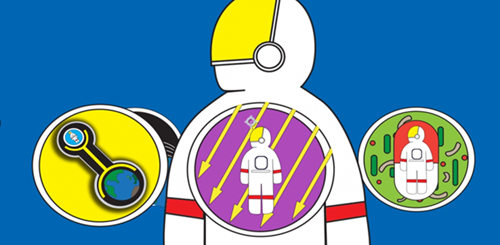Spaceflight Physiology Online
- This course provides students with the basis of knowledge and complement of skills necessary for awareness and application of human spaceflight physiology to the exploration of space. The course will further student’s understanding between space physiology and all the other fields of endeavor within space systems.
- New joint course with the International Institute for Astronautical Sciences (IIAS)
- All students will receive a joint AIAA/IIAS Certificate of Completion at the end of the course.
OVERVIEW
The course provides an overview of the physiological changes and adaptations that occur during each phase of spaceflight: ascent, early orbit, long-term flight, extra vehicular activities, and reentry. It also describes the counter measures in current use. Data from previous and current U.S. and Russian programs are discussed, in addition to current commercial spaceflight ventures. The physiological/life support requirements for spacecraft design are considered, as well as the techniques and potential impacts of crew selection, training, in-flight medical care, and contingencies. Aspects of human participation during exploration class missions/colonization are reviewed. A medical/life sciences background is not required.
LEARNING OBJECTIVES
Upon completion of the course students will be able to:
- Describe those attributes of human physiology requiring protection during space flight with specific reference to the cardiovascular, fluid and skeletal systems.
- Describe the impact of the physiological effects of long duration space flight.
- Describe the evolution of exercise countermeasure systems
- Identify the primary radiation hazards to human physiology
- Explain the role of Activin-A and myostatin as potential mitigation measures.
- Describe the space environment, and describe protection techniques for humans against solar flares, galactic cosmic rays and microgravity.
- Review and list the limitations placed on medical support during exploration class missions.
- Briefly discuss future physiological challenges for missions beyond Earth orbit, including extended stays on the lunar surface and manned missions to Mars. Explain the rationale for human phenotyping, genetic manipulation and human hibernation in the context of long duration missions.
AUDIENCE: Aerospace professionals, graduate students, upper-division undergraduate students
Course Information
Type of Course: Instructor-Led Short Course
Course Level: Fundamentals – Intermediate
Course Length: 2 days
AIAA CEU’s available: Yes
Class 1: Historical Perspectives from John Paul Stapp to present day
Class 2: Human systems adaptation: The Cardiovascular System and Fluid and Electrolyte changes
Class 3: The Skeletal System and bone loss
Class 4: Neurovestibular system and space motion sickness
Class 5: The Muscular System and countermeasures
Class 6: The nervous and immune systems
Class 7: Radiation and its effects on the body and mitigation measures
Class 8: Psychological Considerations/Astronaut ‘select-in’ and ‘select-out’ medical criteria
Class 9: Exercise countermeasures. Operational Space Medicine & Emergency Rescue Support
Class 10: Space Life Sciences Research/ Exploration Class Missions & Human Adaptation. Future applications in LSS, including pantropy, bioprinting, genetic selection & manipulation, holographic technology.
Dr. Erik Seedhouse is an associate professor in Spaceflight Operations at Embry-Riddle Aeronautical University, an instructor at the International Institute for Astronautical Sciences and a science advisor for the Proteus Ocean Group. In 1996, Erik earned his Ph.D. at the German Space Agency’s Institute for Space Medicine. While studying he found time to win Ultraman Hawai’i and the European Ultraman Championships as well as completing Race Across America. Due to his success as the world’s leading ultra-distance triathlete Erik was featured in dozens of magazine and television interviews. In 1997 GQ magazine named him the ‘Fittest Man in the World’. In 1999, Dr. Seedhouse took a research job at Simon Fraser University. In 2005, he worked as an astronaut training consultant for Bigelow Aerospace. Between 2008 and 2013 he served as Director of Canada’s manned centrifuge and Flight Director for hypobaric operations. In 2009 he was one of the final 30 candidates in the Canadian Space Agency’s Astronaut Recruitment Campaign. He holds a sky-diving license, pilots license, is a certified PADI Divemaster and in his spare time works as an occasional film consultant to Hollywood, a professional speaker, triathlon coach, author, and climbs some of the world’s highest mountains as part of his 7 Summits project.
AIAA Training Links
-
For information, group discounts,
and private course pricing, contact:
Lisa Le, Education Specialist ([email protected])

